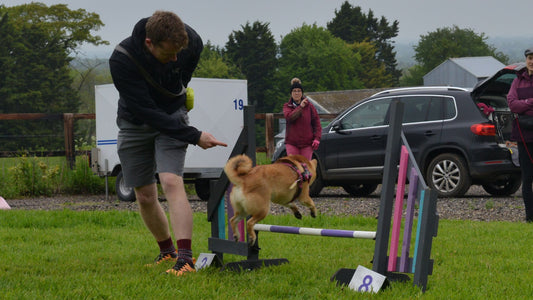We are often asked, “what age can my dog start agility?”. In this article we highlight what scientific research suggests, some considerations to make towards how much exercise and what type of activities a puppy engages and why low impact agility puppy agility foundation training may be suitable for puppies and older dogs.
- Anglian Dog Works Agility engages dogs in controlled activity during our dog agility classes near Cambridge.
- The exercises are designed to gradually increase their physical and mental demand; the increments are well thought out and researched.
- The puppy agility foundation training does not involve high impact exercises such as jumping full-height jumps or sharp turns in weaves; beginner dog agility classes only feature short sequences of agility equipment.
- High impact activity will be avoided until maturity and a period of adequate conditioning, agility and strength training has been undertaken.
- Dogs should be free of hip and elbow dysplasia, and genetic tendencies to conditions such as osteochondritis dissecans. Any dog that shows pain and discomfort, should be seen by a vet straight away.
The science:
What are growth plates?
Growth Plates are areas of soft cartilage at the end of bones that lengthen in a growing dog as they get bigger. As the dog matures, the growth plates calcify, harden, and turn into denser bone material.
At what age do dogs stop growing?
Growth plates close at a predictable age, based on the size of the dog. The colours in the charts below indicate when the growth plates close at those joint in different sized dogs.

Figure 1 Catherine Marshal Veterinary Physiotherapists – Large Breed Growth plate closure

Figure 2 Catherine Marshal Veterinary Physiotherapists – Toy Breed Growth plate closure
There is no evidence that normal exercise causes damage to growth plates of puppies [1]
Pre agility puppy training is suitable for all dogs who have had their vaccinations and are six months and onward.
Does exercise risk joints?
In human’s, physical activity contributes to bone density during childhood. Just like other mammals’ dogs’ benefit from exercise during growth. It increases bone accretion.
Studies suggest that off-lead activity protects against certain joint problems [2] [3]
So, it can be concluded that regular exercise is beneficial to normal joints [1]
However, as some research indicates that jarring, high impact activity may be risk factors for some joint conditions [4] we feel it is sensible advice to avoid full height jumps and weaves during the formative months in our dog agility training for beginners’ classes.
How to book:
For all enquiries and booking requests, please click here to use the contact form on our website.
Bibliography
|
[1] |
D. D. Millis, "Mylamedog.com," [Online]. Available: https://www.mylamedog.com/post/what-is-the-logic-behind-not-exercising-puppies-until-the-growth-plates-are-closed?fbclid=IwAR3XIFhwinAdtEVLwEhMgiZsG70ZIXoT8EaIVXHDtfaZS4VAN2MZxyBidAQ . [Accessed 07 06 2021]. |
|
[2] |
A. N. B. K. S. E. R. C. T. Randi I Krontveit 1, "Housing- and exercise-related risk factors associated with the development of hip dysplasia as determined by radiographic evaluation in a prospective cohort of Newfoundlands, Labrador Retrievers, Leonbergers, and Irish Wolfhounds in Norway," American Journal of Veterinary Research, vol. 73, pp. 838-846, 2012. |
|
[3] |
M. H. S. e. al, "Diet, Exercise, and Weight as Risk Factors in Hip Dysplasia and ElbowArthrosis in Labrador Retrievers," The WALTHAM International Nutritional Sciences Symposia, vol. 136, p. 2050S, 2006. |
|
[4] |
M R Slater;J M Scarlett;S Donoghue;R E Kaderly;B N Bonnett;J Cockshutt;H N Erb, "Diet and exercise as potential risk factors for osteochondritis dissecans in dogs.," American journal of veterinary research. , vol. 53, pp. 2119-2124, 1992. |
About the author:
Hi 👋 I’m Emma, accredited as a professional dog trainer by the Institute of Modern Dog Trainers (IMDT). I help owners of energetic dogs achieve the dog-owning life they envisioned by providing robust obedience & agility training for dogs in Balsham, near Cambridge.
Disclaimer: The content of this article does not include personalised advice and is for information purposes only. If you need individual advice or other enquiries please click here to get in contact or if you're not local to Anglian Dog Works, you can find a trainer in your area by going to the IMDT website: https://www.imdt.uk.com/find-a-qualified-imdt-trainer



